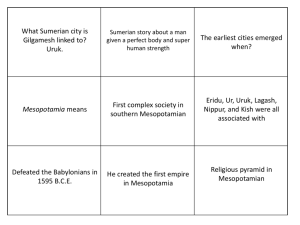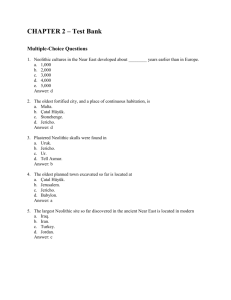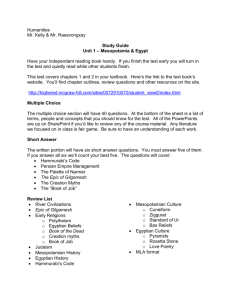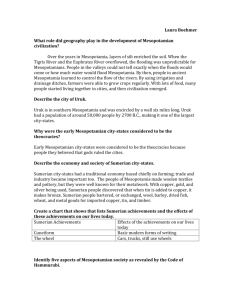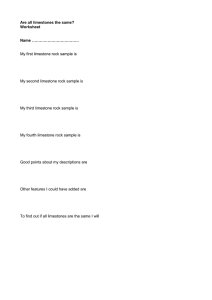AP ART HISTORY: SHMERYKOWSKY MESOPOTAMIAN ART
advertisement
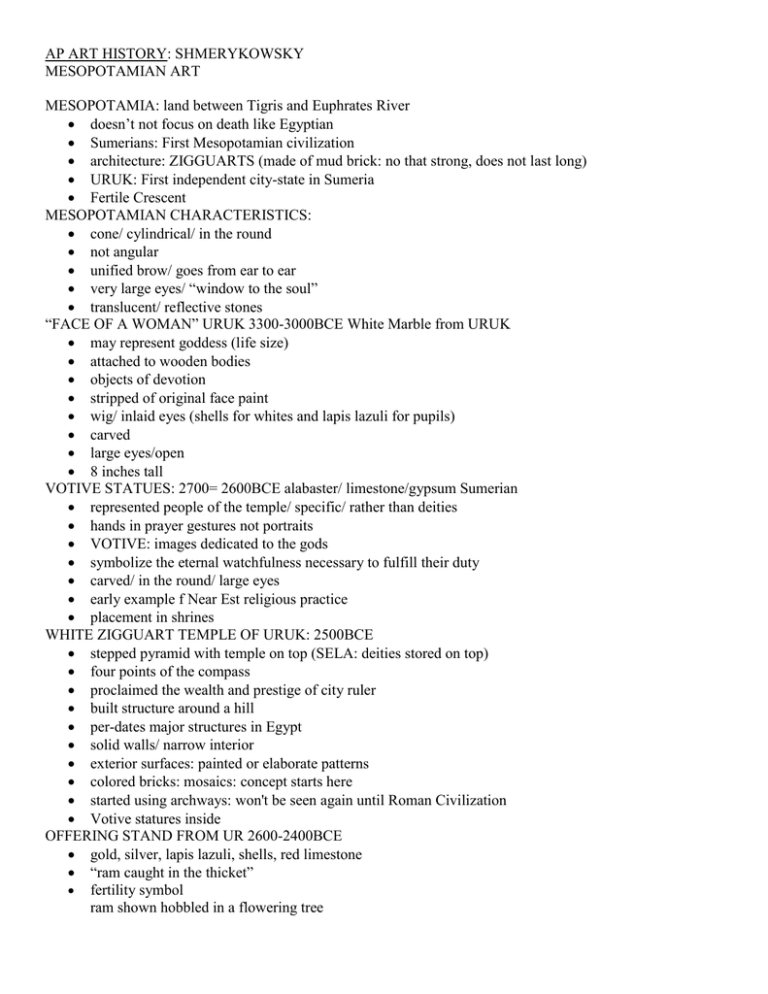
AP ART HISTORY: SHMERYKOWSKY MESOPOTAMIAN ART MESOPOTAMIA: land between Tigris and Euphrates River doesn’t not focus on death like Egyptian Sumerians: First Mesopotamian civilization architecture: ZIGGUARTS (made of mud brick: no that strong, does not last long) URUK: First independent city-state in Sumeria Fertile Crescent MESOPOTAMIAN CHARACTERISTICS: cone/ cylindrical/ in the round not angular unified brow/ goes from ear to ear very large eyes/ “window to the soul” translucent/ reflective stones “FACE OF A WOMAN” URUK 3300-3000BCE White Marble from URUK may represent goddess (life size) attached to wooden bodies objects of devotion stripped of original face paint wig/ inlaid eyes (shells for whites and lapis lazuli for pupils) carved large eyes/open 8 inches tall VOTIVE STATUES: 2700= 2600BCE alabaster/ limestone/gypsum Sumerian represented people of the temple/ specific/ rather than deities hands in prayer gestures not portraits VOTIVE: images dedicated to the gods symbolize the eternal watchfulness necessary to fulfill their duty carved/ in the round/ large eyes early example f Near Est religious practice placement in shrines WHITE ZIGGUART TEMPLE OF URUK: 2500BCE stepped pyramid with temple on top (SELA: deities stored on top) four points of the compass proclaimed the wealth and prestige of city ruler built structure around a hill per-dates major structures in Egypt solid walls/ narrow interior exterior surfaces: painted or elaborate patterns colored bricks: mosaics: concept starts here started using archways: won't be seen again until Roman Civilization Votive statures inside OFFERING STAND FROM UR 2600-2400BCE gold, silver, lapis lazuli, shells, red limestone “ram caught in the thicket” fertility symbol ram shown hobbled in a flowering tree MESOPOTAMIAN CYLIBER SEALS: 3000-1000BCE stone with carvings Sumerian a way for identification/ protect against unauthorized ownership CUNEIFORM stone cylinders and rolled them over clay to produce miniature artworks BULL LYRE: 2600BCE harp from Royal grave of Ur “kings Grave” Kind Meskalamdug Sumerian beard: power/ importance wood with gold leaf/ inlaid designs intensely lifelike despite blue patterned beard/ various mythic scenes with gods as half human/ half animal side view: story of Epic of Gilgamesh: heroic feats 4 horizontal REGISTERS (similar to Egyptian) HEAD OF A MAN: 2250BCE Akkadian Civilization beard= symbol of importance strands of hair: very detailed Connects to King Tutankhamen: stylized, simple curls, straight, smooth, edgy CASTED BROZE: “lost wax process”: clay/ wax usually first, metal poured on top, clay pulled out/ wax melted first known life size hollow cast of head captured distinct features: male ideal VICTORY STELE OF NARAMSIN Pink Sandstone 2230BCE almost 7ft tall commemorate conquest in Lullubi: Naramsin leading army up a mountain staggered figures: abandoned registers ruler above everyone profile head/ frontal body overlapping people/ foreshortening composition flexible horned head: identify with gods unified narrative on one stone vessel: life giving waters STELA: **Similar to Palette of King Narmer LAGASH CIVILIZATION: SEATED STATUTE OF GUDEA HOLDING TEMPLE PLAN 2100BCE Diorite 2'5” Gudea (king) Built' rebuild many temples and placed statues of himself in them seated portraits large chest: fullness of life like muscular arms: god given strength cylindrical/ wide eyed/ no personality/ generalized CODE OF HAMMUARABI 1770BCE Carved diorite 7ft tall Babylon (city capital) large cylinder/ certain later has relief everything carved in full profile king looking into eyes of deity= as equals (sun god) underneath: Code of Hammurabi predates Mosaic law ASSYRIANS most developed art work major complex: PALACE OF KING SARGON 1400BCE citadel: fortress 200 rooms/ 30 courtyards stone gate: high relief man-headed/ winged bull: detailed “GAURDIAN FIGURES: 2700 BCE Limestone 13-16 feet tall weight of 40 tons flanked citadel gateways beard= importance horned headpiece= deity Mesopotamian eyebrow 3 quarter view- 5 legs/ frontal view: 2 legs/ side view: 4 legs realistic details ASSURNASIRPALL KILLING LION/BEAST 850BCE Alabaster (semi-translucent) lions revered animals sense of timelessness towards visual narrative man confronting beasts: not as equals but to dominate DYLING LIONESS: 720BCE Limestone shows high emotion: PATHOS dignity in death SACK OF THE CITY: 650 BCE Limestone destruction/ plunder of the city attempt at perspective/ people all the same size/ overlapping King in front still some frontal torso/ profile head naturalism to animals unified narrative (contrasting Stele of Naramsin) NEO-BABOLONIAN: NEBERKANEZER (ruler) Babylon was one of the largest/ greatest cities of Ancient World ISHTAR GATE: 600 BCE using archway/ colored bricks (mosaic)/ turquoise brick glazed striding lions: symbol of goddess Ishtar (fertility, love and war) double archways symbol of power of Babylonian power THRONE ROOM 575BCE PESIANS: vast empire under Siris II 559BCE (governor official_ Darius: Son of Sirus: Persepolis (city named by Greeks) Rules: 521-486BCE Imported all over empire: Persian, Egypt, Greek, Mesopotamia: political strategy developed fair taxation standards/ currency/ important communication throughout empire Created complex on raised platform/ on rectangular grid/ only access via ramp RESIDENCE (AUDIENCE HALL) 518-460BCE small palace/ square hall/ ho0lds several thousand people: RECEPTION SPACE Reliefs: ranks of royal guards and delegates of tributes holding gifts/ towards center not like Assyrian reliefs (for King) Persian reliefs (for the people: extent of empire and economic prosperity) Egyptian stylized with Mesopotamian details (multi-ethnic) PLAN OF CEREMONIAL COMPLEX: Persepolis 518-460BCE HALL OF 100 COLUMNS: Meeting Room ceremonial reliefs around the walls of this room BULL CAPITAL FROM PERSEPOLIS 400BCE Stone flat in middle: lintel DARIUS AND XERXES RECEIVING TR$IBUTE 491-486BCE Limestone detail relief from stairway leading to APADANA: Ceremonial Complex: Persepolis depicts allegiance or economic prosperity freshly painted: rich tones ACHAEMENID: PERSIAN GRIFFIN CAPITAL AT PERSEPOLIS about 515-510BCE Double PROTOME capital: adornments of frontal views of animal heads
